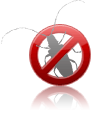Spruce needle cushion rust

- Latin : Chrysomyxa abietis (Wallr.) Unger
- English: Spruce needle cushion rust
- French: Rouille annulaire des aiguilles de l’épicéa
- Order/Class: Stilbellales
Description
Distribution
This species is not found in Canada
Micro-habitat(s)
Needle
Damage, symptoms and biology
Spruce needle cushion rust is a disease caused by a fungus belonging to the Basidiomycetes, a large group of fungi. It causes discoloration of the current-year needles, specifically, light green or yellowish green horizontal bands or stripes, and later, yellow-orange bands. These bands, which appear on the foliage in the spring, are the first visible symptoms of the disease. The fungus penetrates into the needle over the summer. The telia (the fruiting bodies of the fungus) that form in the fall sporulate and the resulting teliospores (asexual spores) give rise to basidiospores (sexual spores) the following spring. Telia develop as thick cushion-like, orange-yellow (nearly red) structures within the transverse bands on the needles. This is the form in which the fungus overwinters in the living needles. Although Chrysomyxa abietis produces two types of spores, the disease is spread by the basidiospores. These spores are distributed by the wind, in May and June, infecting young developing needles on nearby trees. Most of the infected needles are shed the following spring. Heavy defoliation sometimes occurs. A high relative humidity, over 90%, lasting for a long time favoured epidemic development of the disease in areas of Finland in 1998. At that time, Norway spruce mortality was greater than 60%.
Comments
Unlike some other spruce rusts, spruce needle cushion rust does not require an alternate host. Chrysomyxa abieitis is an autoecious or microcyclic rust. It colonizes the needles of spruce trees, particularly trees less than 20 years old, growing in dense stands. A cool, wet spring provides conditions favourable for fungal development. Infections are rarely extensive; they are typically localized and occur at lower elevations between 400 and 1700 m. Dense young plantations located in environments characterized by high humidity levels are particularly vulnerable.
In Finland, a hyperparasite fungus, Eudarluca caricis (Biv.) O.E. Erikss., regularly infects C. abietis fruiting bodies.
References
[Anonyme]. 1989. Chrysomyxa abietis. [Distribution map]. CAB International, Distribution Maps of Plant Diseases, (Edition 1) Map 615.
Abgrall, J.F.; Soutrenon, A. 1991. La forêt et ses ennemis, 3e édition. CEMAGREF, Grenoble. pp. 207-210.
CAB International. 1989. Distribution Maps of Plant Diseases, Map 615. CAB International, Wallingford, UK.
Collins, M.A. 1976. A note on the distribution of Chrysomyxa abietis Unger in Scotland. Scott. For. 30:127-130.
Farr, D.F.; Rossman, A.Y. [N.D.]. Fungal Databases, Systematic Mycology and Microbiology Laboratory, ARS, USDA. http://nt.ars-grin.gov/fungaldatabases/. Consulté le 19 décembre 2011.
Global Biodiversity Information Facility. Chrysomyxa abietis (Wallr.) Unger 1840. http://data.gbif.org/species/14377170/. Consulté le 14 novembre 2008.
Mordue, J.E.M.; Gibson, I.A.S. 1978.Chrysomyxa abietis. [Descriptions of Fungi and Bacteria]. IMI Descriptions of Fungi and Bacteria (No. 58) Sheet 576, 2 pp.
Nienhaus, F.; Butin, H.; Böhmer, B. 1999. Maladies et ravageurs des arbres et arbustes d’ornement. Éditions Eugène Ulmer. 288 pp.
Nierhaus-Wunderwald, D. 2000. Les rouilles de l’épicéa. Notice pour le praticien 32, Institut fédéral de recherches WSL, Birmensdorf, Suisse. 8 pp. http://www.wsl.ch/publikationen/pdf/4094.pdf. Consulté le 17 mars 2008.
Spaulding, P. 1956. Diseases of North American Forest Trees Planted Abroad. U.S. Department of Agriculture, Agriculture Handbook No. 100. 144 pp.
Uotila, A.; Wang, T.; Wang, L. 2000. Some ecological aspects of Chrysomyxa abietis (Wallr.) Unger epidemiology. Metsanduslikud Uurimused XXXIV:17-23.